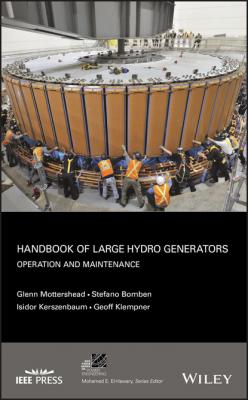Handbook of Large Hydro Generators. Geoff Klempner
Читать онлайн.| Название | Handbook of Large Hydro Generators |
|---|---|
| Автор произведения | Geoff Klempner |
| Жанр | Техническая литература |
| Серия | |
| Издательство | Техническая литература |
| Год выпуска | 0 |
| isbn | 9781119524168 |
3 Chapter 3Figure 3.1-1 Shows oil pot labyrinth seal at the top.Figure 3.1-2 Shows a typical high hat or chimney tube.Figure 3.2-1 Typical tube type surface air cooler.Figure 3.2-2 Shows typical water box on one side of surface air cooler.Figure 3.2-3 Cross section of a heat exchanger tube, showing the inner tube ...Figure 3.3-1 Thrust bearing cooling coil.Figure 3.3-2 Simple copper tubing used for cooling of the oil inside an oil ...Figure 3.4-1 Simplified Schematic of the pure water system piping.Figure 3.4-2 Relationship between conductivity and pH under ideal conditions...Figure 3.5-1 Shows pilot and main rotating exciters.Figure 3.5-2 Schematic of a shaft‐driven, rotating pilot and main excitation...Figure 3.5-3 Typical stator or stationary field.Figure 3.5-4 Typical rotating exciter armature.
4 Chapter 4Figure 4.1-1 Typical nameplate for a hydro generator.Figure 4.1-2 Schematic representation of a generator feeding a load through ...Figure 4.1-3 Typical capability curve for internal utility use.Figure 4.1-4 Typical saturation curve for transformers and generators.Figure 4.1-5 Hysteresis losses under normal and abnormal conditions.Figure 4.1-6 Manufacturer issued V/Hz curve.Figure 4.3-1 Open circuit and short circuit characteristics.Figure 4.3-2 Typical open circuit saturation characteristic.Figure 4.3-3 Typical short circuit characteristic.Figure 4.3-4 Typical capability curve from the manufacturer.Figure 4.3-5 Basic capability curve for internal utility use.Figure 4.3-6 Another manufacturer curve showing saliency circle and theoreti...Figure 4.3-7 Typical V‐curve from the manufacturer.Figure 4.5-1 Armature reaction.Figure 4.5-2 How the armature reaction affects the output voltage of a gener...Figure 4.5-3 Generator equivalent circuit.Figure 4.5-4 Vector representation of the fundamental circuit equation.Figure 4.5-5 Power transfer function applied to the power transferred betwee...Figure 4.5-6 Graphic representation of the fundamental circuit equation.Figure 4.5-7 Graphic solution for change of excitation from IF1 to IF2.Figure 4.5-8 Numerical example for Case 4.3.Figure 4.5-9 Continuation of Case 4.3 numerical example.Figure 4.5-10 Graphical representation of change in power.Figure 4.5-11 Numerical example for Case 4.4.Figure 4.5-12 Calculation of circulating current between two generators conn...Figure 4.5-13 Out‐of‐step mechanical conceptualization.Figure 4.5-14 Power system stability case with two lines and two busses befo...Figure 4.5-15 Simple case of generator stability from the generator perspect...Figure 4.6-1 Sets of balanced and unbalanced three‐phase phasors. (a) Balanc...Figure 4.6-2 An unbalanced set of three‐phase phasors and its symmetrical co...Figure 4.6-3 Symmetrical sequence components.Figure 4.6-4 Generator subjected to a phase‐to‐phase short circuit on its te...Figure 4.7-1 Typical life endurance of a shaft under periodic torsional stra...
5 Chapter 5Figure 5.3-1 Polar graph of instantaneous temperature magnitude for all hose...Figure 5.3-2 One hose‐outlet sensor indicating plugging as temperature in re...Figure 5.5-1 Embedded core thermocouple on lamination. Note that this figure...Figure 5.5-2 V/Hz curve.Figure 5.5-3 Core accelerometer placed on back of core between keybar and co...Figure 5.5-4 Limits for vibrational displacements [4].Figure 5.5-5 Illustration of a slot RTD installed in separator pad and locat...Figure 5.5-6 Fiber‐optic stator endwinding vibration transducer.Figure 5.5-7 Loose circuit ring vibrating and the white powder produced agai...Figure 5.5-8 Shows typical location of the partial discharge couplers on the...Figure 5.5-9 The Iris Power PDA‐IVRP instrument.Figure 5.5-10 Slot discharge from loss of the semiconducting coating or coro...Figure 5.5-11 Internal and slot discharges.Figure 5.5-12 Shows stator core and parasitic currents.Figure 5.5-13 Shows the electrical arc as bar is vibrating and contact is lo...Figure 5.5-14 Shows the various locations for surface discharges in the endw...Figure 5.5-15 Damage at the semiconducting/stress control interface just out...Figure 5.5-16 Endwinding discharges where conductive debris is extending the...Figure 5.6-1 Radio‐frequency monitoring.Figure 5.7-1 A simple schematic for PD coupler locations on the generator wi...Figure 5.7-2 Typical partial discharge coupler installation.Figure 5.8-1 Plan view of the SSC installation.Figure 5.8-2 Stator slot coupler end view.Figure 5.8-3 Installed stator slot coupler.Figure 5.9-1 Shows a flux probe installation in progress on the stator core....Figure 5.9-2 Software output for flux probe data collected.Figure 5.9-3 Polar representation of flux probe data collected showing short...Figure 5.9-3 Shaft grounding brush.Figure 5.9-4 Airgap system architecture.
6 Chapter 6Figure 6.1-1 Single‐function protective relay.Figure 6.1-2 Schweitzer Engineering Laboratories SEL 300G multifunction rela...Figure 6.1-3 Beckwith Electric Co. Inc. M‐3425A multifunction relay.Figure 6.1-4 Beckwith M‐3425A multifunction generator protection outline (ty...Figure 6.3-1 High impedance ground protection and grounding transformer.Figure 6.3-2 Subharmonic voltage injection scheme.Figure 6.3-3 Protection using two loss of excitation relays.Figure 6.3-4 Example of a voltage balance relay circuit.Figure 6.3-5 Example of a generator with one PT feeding its protection and e...Figure 6.3-6 Functional diagram of a generator zone breaker failure scheme....Figure 6.3-7 Approximate equivalent circuit.Figure 6.3-8 Generator percentage differential relay slope characteristic.
7 Chapter 7Figure 7.1-1 Shows the effects of a metallic object on the surface of a stat...Figure 7.1-2 Foreign material caused serious core damage.Figure 7.2-1 Ground leads applied to the generator bus at the switchgear.Figure 7.5-1 Example set of inspection tools.Figure 7.5-2 Typical borescope with articulating head.Figure 7.5-3 Pocket knife used to spot check core tightness.
8 Chapter 8Figure 8.1-1 Shows bare
